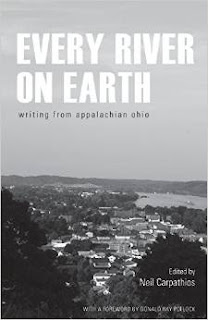I read many compilations by and about Appalachians. But seldom have I read a collection so rooted in place as Every River on Earth: Writing from Appalachian Ohio published earlier this year by Ohio University Press. Edited skillfully by poet Neil Carpathios, the coordinator of the creative writing program at Shawnee State University in Portsmouth, this intriguing collection is divided into four parts that speak to the paradox of Appalachian experience as defined in southern Ohio.
Carpathios acknowledges his "transplant" status in the introduction to the book's themes,"…this anthology started with a personal, maybe even somewhat selfish desire to better grasp my new home," he says. Winnowing the 400 plus submissions down by the primary criterion of "quality," Carpathios sought to include a variety of styles, subjects and voices that he says took on a life of their own, falling organically into four sections: "Family and Folks," "The Land," "The Grind," and "Home and Away."
The book takes its title from David Lee Garrison's poem which includes this lyric tribute to the land:
"Wind pokes the land in winter,
trying to waken it,
and in the melting snow
I see rainbows and in them
every river on earth."
Donald Ray Pollock provides the longtime resident's perspective in his foreword to the anthology when he says, "no, I can't think of anywhere I'd rather live." Even though he admits his life in Knockemstiff has included factory work, hard living and eventually an alcohol and drug rehab, he asserts that while there is "ugliness and despair and heartbreak in these hills, there is also much goodness and mystery and beauty." Later in the anthology, the reader is treated to the beauty that Pollock makes of heartbreak in his story of forgiveness, "The Jesus Lights."
In the opening section, "Family and Folks," I was instantly charmed with the poetic voice employed by Roy Bentley, with Jeanne Bryner's stunning imagery when describing her farmer neighbor at work, and by the sense of magic in poet, Cathryn Essinger's "The Way Things Are." Ed Davis takes a surprising offer from a desperate widower to create "a boiling Appalachian stew" from his novel-in-progress. And I am still giggling from Janet Ladrach's "The Farmer's Wife's Vacation."
The second section includes homage to the landscape of southern Ohio including two of my new favorite tributes to sycamores by Cathryn Essinger and Richard Hague. Essinger entitles her poem "Someday the sycamores…" and in her playful lines, supposes that someday these trees are simply going to walk away in reaction to an ever-hovering danger from development. She closes her poem with these lines:
"And if you watch carefully, if you sit down in the dark
when the moon, that old tattletale, is out of sight,
you will see them stand
on gnarled knuckles and inch away, see them gather up
their children, hand in hand, and even if you call,
they will not come back."
Richard Hague is a Cincinnatian who has published 14 books, many that are set in eastern and southern Ohio. In his nonfiction contribution, he describes how easy it is to forget that we live in a natural world when the city swallows so much of it. Hague relates the sycamore hunts he and his late friend, Joe Enzweiler used to plan together. He also crafts many indelible descriptions of the trees:
"The sycamores edged the stream like a procession of white-robed deacons."
The third section of the book is entitled "The Grind." It is here that we read about the difficulties of living in Appalachian Ohio. Those ugly, desperate heartbreaks that Donald Ray Pollock warns us about in his foreword. Among my favorite reads from this section--which was heavier on prose than the other sections--are Michael Henson's "Coming Home," "Destroying New Boston" by Brooks Rexroat and of course, "The Jesus Lights" by Donald Ray Pollock. In these raw stories, a recovering addict gets thrown right back into the path of cronies who will surely drive her to drugs, a bunch of bored teenagers accidentally wreck part of a town's painful heritage, and a man's grief illuminates a path for forgiveness. While the circumstances in many of these tales are bleak, the characters are not. Many of them discover "the goodness and the mystery and the beauty" in their plights.
The final section, entitled "Home and Away" is largely devoted to those looking back at southern Ohio from somewhere else. Whether it be Los Angeles, New Orleans or a fourteenth floor apartment, the characters and speakers look back homeward over time and distance. My favorites from this section include Ronald D.Giles' "The Friday Night Dance," and Hayley Hughes' "The Fair." Both are personal stories, but from very different time periods. Giles writes of an eighth grade dance experience in the 1950s while Hughes shares her more recent adventures at the Ohio State Fair with her father-- from her earliest recollections to her twenty-sixth year. While Giles' maintains a strict narrative timeline, Hughes bounces around her quirky personal essay revealing the tricky relationship she maintains with home and family. I also enjoyed the found poem in this section entitled "Portrait of Southern Ohio in Five-Syllable Road Signs" by Adam Sol.
While Every River on Earth laments the ugliness, despair and heartbreak of Appalachian Ohio. its quality of writing is testament to the goodness, mystery and beauty rising from a deep sense of place. Several of the authors have a reading scheduled at Joseph-Beth Cincinnati on April 4th at 2 pm. You just might want to be there if you enjoy masterful writing or a great yarn.
This review originally aired on WVXU.org's AROUND CINCINNATI on March 27, 2015. You can listen to the review at this link: Listen to this review.


No comments:
Post a Comment